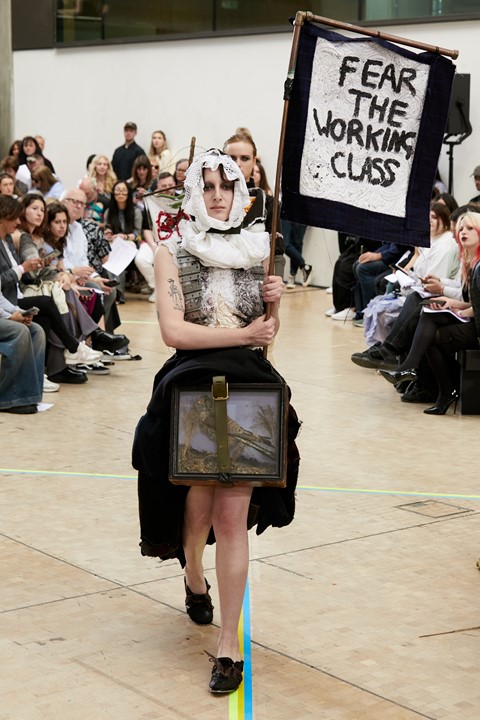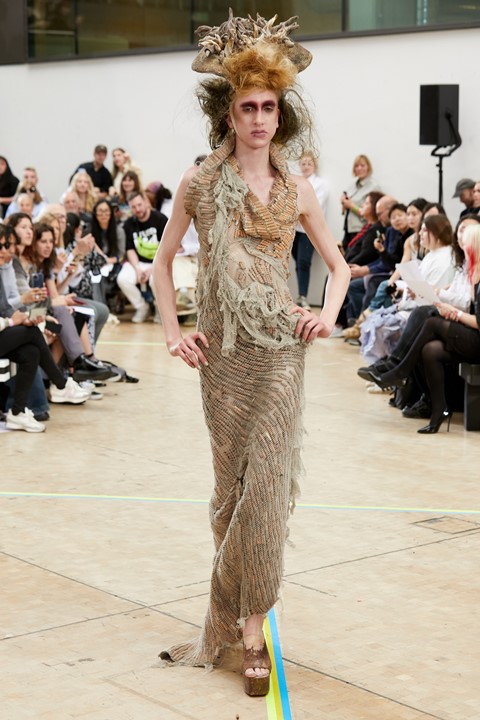What happened to the great British working-class fashion designer?

Could Alexander McQueen, John Galliano, and Vivienne Westwood kickstart a career in today’s climate? And what do we lose when our most confrontational talents can’t survive the fashion system?
Introducing Horror Nation?, a new season from Dazed about the current state of the UK from the perspective of the young people who live here.
A secondary school teacher is sitting on a plastic chair in her Luton classroom, hands wrapped around a mug of tea. “There’s a whole generation of students who don’t even know that they’re good artists,” she says in Breaking The Class Ceiling, tears filling her eyes. “They don’t realise that human beings need to create in order to be happy and they’re almost cackhanded as a result because their dexterity has suffered.” She connects her observations to the government’s widespread defunding of the arts, which has led to a 37 per cent reduction in state schoolers taking creative GCSEs, while private schools remain untouched. Class tensions there will always be, but an accretion of immiserating cuts threatens to create a two-tier system where only the rich can afford to make art.
Would designers like Alexander McQueen, John Galliano, and Vivienne Westwood – all of whom are heralded as game-changing, working-class heroes – even be capable of kickstarting a career in today’s climate? After all, why would someone from a low-income background want to aggravate their poverty by entering an industry that is economically structured against them? “I’ve always known that in order to achieve any kind of success, I’d have to get into debt first,” says TJ Finley, who will be graduating from Central Saint Martins with a BA in knitwear later this year. “I’m from Doncaster and I wanted to move to London and student finance enabled me to do that. It’s impossible to escape debt when you’re not from money,” he adds. “Death and debt, that’s what my dad always taught me.”
It’s never quite been this impossible, though. In the 80s, broke creatives often lived in and worked from illegal squats. Stephen Jones famously occupied a disused building on Warren Street with Boy George and Princess Julia, while Galliano and McQueen (who was on the dole) both had family in London. “People can’t do that now because there’s not a single space you can use without paying rent,” Finley says. “You’re paying £1,000 to live in a warehouse room with damp and mould and no windows. And there are CCTV cameras everywhere, it’s a different time.” CSM students still like to inhabit that bohemian spirit of their predecessors – shoplifting literally anything from the Waitrose in Granary Square – but when the university runs a literal food bank, the performance feels quite bleak.
“It’s made it harder for people without money to survive,” Finley continues. “I think there were about three working-class people on my course. You also have to remember that when McQueen and Galliano were studying there were like 30 students in the entire year. That number has now gone up to 200 so it’s getting worse and worse because the facilities aren’t growing and you still have to pay for everything.” Part of the issue is that universities in the UK have become businesses rather than institutes of learning – their principal source of funding has shifted from government grants to tuition fees – meaning art schools like CSM rely on wealthier students to turn revenue. “If poor people want to use their facilities, these colleges also need the rich kids to do £5,000 per term summer schools.”

One of these programmes, Fashion Folio, is positioned as a down payment for international students to land a place on an otherwise oversubscribed degree. “I think there were about 50 people that did that to get onto my course,” says Hannah Garner, a final-year womenswear student who had never heard of CSM before she applied. “I just went to get out of Carlisle, I didn’t even know who Alexander McQueen was back then. You don’t have time to worry about those kinds of things, you’ve got holes in your shoes, you’ve just got to get on with it.” Garner worked part-time at a pub before she landed a BFC scholarship, while her peers paid for seamstresses to create their final collections. “Everything is a barrier because it’s just so much money to do anything. A French seam is like £30, it’s ridiculous.”
She says it was much the same for one of her art teachers in Carlisle, who studied alongside Stella McCartney and Phoebe Philo in the 90s. But the number of working-class creatives has more than halved since then, which is a direct consequence of a sad island that refuses to value the cultural health of its inhabitants. “I mean art is just so bad at the minute, isn’t it? We’ve got ten Fast and Furious movies! Capitalism is crumbling and you need to be someone’s daughter to get anywhere,” Garner says. Is that a reliable system that someone without prior connections is going to be attracted to? “I used to think I could make a socialist revolution when I joined CSM but I don’t think that’s the case anymore. I really don’t wanna be part of the problem so I’m looking at getting a ‘normal’ job.”

It’s perhaps the smartest thing to do considering the university warns its students that “not many people will get a job.” And even if a designer does score a prestigious place on NEWGEN or Fashion East – which have beamed many a working-class designer into the spotlight – long-term success is rarely guaranteed. “There’s no ‘next stage’ and that’s a massive gap. It’s not just about schools being brainwashed into doing STEM or the living costs of being a student. It’s about what happens next?,” Tamara Cincik of the Fashion Roundtable think tank says. “The churn is massive and it’s a waste of talent. I mean, McQueen was the last house to have come from the UK. Some people will pursue that dream because they’re driven, but not everyone will be as confident. There’s just not enough support.”
That the marginalised and the working class should make more confrontational work than the privileged is a time-worn truism. “They’re not even making interesting art,” Garner says. “They’ve not had as much life experience so they just base it all on Chanel.” During this year’s graduate showcase, Garner sent out a gloom of dishevelled models who looked as though they had been impaled with pipes. They carried flags with “Fear The Working Class” scribbled on them, which could have been a warning for when Finely emerged onto the catwalk, hobbling and hollering and pelting the audience with hundreds of putrid cigarette butts. “I think it’s a blessing being working class,” he says. “You’re unhinged and you have nothing to lose and you’re more transgressive in your work because of that. Even when the rich students are trying to be experimental it still feels polite.”
Both of them survived on hardship funds and scholarships, crafting their collections from street-sourced rubbish. “We don’t give a fuck because we can’t afford to,” Garner explains. “We’re not arsed.” Sarah Mower and Damian Hurley weren’t best pleased after getting doused in fag ash but it’s that trouble-making, subversive spirit that first turned critics away from McQueen, too. What we lose when working-class designers are suffocated, are those willing to offend and speak back to the system, those who oppose commercial tastes, and those who move the culture forward. “I don’t think you’re supposed to make things that people are comfortable with,” Finley concludes. “Is that all you want? For someone to say ‘Oh that’s nice’? No! Get them angry. Get them to walk out of your show.”
- June 16, 2023













